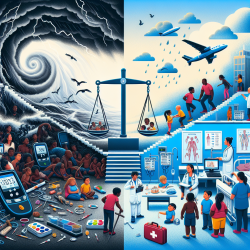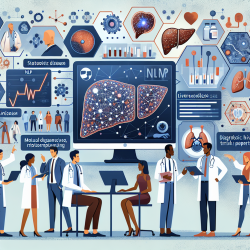Introduction
Natural disasters, such as hurricanes, pose significant challenges to healthcare systems, particularly for individuals with chronic conditions like diabetes. The study "Evaluating emergency preparedness and impact of a hurricane sandy in pediatric patients with diabetes" provides valuable insights into how we can better prepare and manage diabetes care during such events. This blog will explore the study's findings and discuss how practitioners can leverage this data to improve outcomes for pediatric patients.
Key Findings from the Study
The study involved 142 families caring for children with Type 1 Diabetes Mellitus (T1DM) from hospitals in Bronx, NY, and Hackensack, NJ. It assessed their preparedness for Hurricane Sandy and its psychological impact. Here are the key findings:
- 95% of families reported being generally well to moderately prepared for the hurricane.
- 83% were very well prepared regarding their child's diabetes management during the disaster.
- Socioeconomic status (SES) was not related to preparedness for diabetes management, although it was associated with glycemic control.
- New Jersey subjects exhibited a trend towards greater psychological impact from the hurricane.
Implications for Practitioners
These findings highlight the critical role of preparedness in managing chronic conditions during disasters. Practitioners can enhance their skills and improve patient outcomes by focusing on the following areas:
- Emergency Preparedness Education: Educate families on the importance of having a disaster supply kit, including diabetes-specific supplies like insulin, glucose meters, and emergency contact plans.
- Community Support Systems: Encourage the development of community networks that can provide support and resources during emergencies, particularly for low SES populations.
- Psychological Support: Implement strategies to address the psychological impact of disasters on children with diabetes, as stress can affect glycemic control.
- Interventional Studies: Design and implement studies to maintain glycemic control during disasters, ensuring that interventions are ready to deploy when needed.
Encouraging Further Research
While this study provides valuable insights, it also highlights areas for further research. Understanding the factors that contribute to effective disaster preparedness, especially in low SES populations, can inform strategies to improve glycemic control and overall health outcomes. Additionally, exploring the psychological impact of disasters on children with diabetes can lead to better support systems and interventions.
Conclusion
Hurricane Sandy's impact on pediatric diabetes care underscores the importance of emergency preparedness and the need for targeted interventions. By leveraging the findings of this study, practitioners can enhance their preparedness strategies and improve outcomes for children with diabetes. For more detailed insights, read the original research paper.










